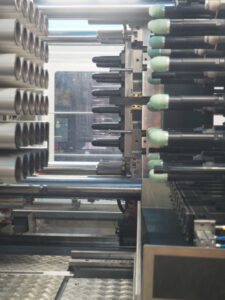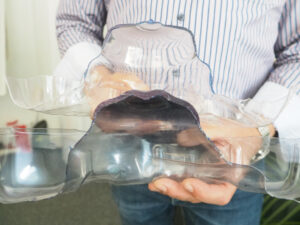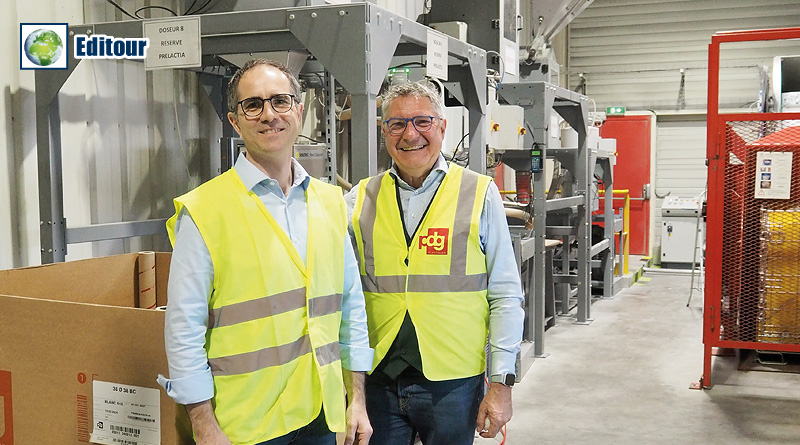Saving material on the floor is sustainable
Customer satisfaction is always the top priority for François Desfretier, Managing Director of PDG Plastiques. His customers don’t just come to PDG with standard enquiries – they also approach him with projects that other converters don’t really dare to tackle. PDG has built up a highly specialised machine park for this purpose. In addition to the 20 Netstal systems, there will also be one of the first Otto Systems units for preforms of large-volume containers with 16 cavities, a small 1Blow machine with two cavities for small batches with a new technology for moulding deep recessed grips in the containers. Also in use is a SIPA system for sparkling wine and wine bottles – to name just a few examples. But first things first:
Interview with PDG Plastiques // April 8, 2025
Photo top: F.l.t.r.: François Desfretier, CEO PDG, next to Philippe Blonda, Business Development in front of the mixing plant for virgin and rPET material
Material supply: complexity from the first step
This is where the complexity of the process begins. Many preforms and bottles contain different proportions of rPET. This is mixed with new material in a mixing station (see image above) according to the desired proportion and then passed on to the dryer. François Desfretier, CEO of PDG, would like the industry to agree on fixed rPET percentages – for example 25 %, 50 % and 100 % – and for the material to be supplied ready-mixed by the raw material manufacturer. In the long term, he sees chemical recycling as the solution, as it ensures less contamination and guarantees consistently high material quality.
State-of-the-art logistics: round the clock versatility of AGVs

Five AGVs (Automated Guided Vehicles) have been handling in-house logistics since 2024. They move along fixed routes or with the help of modern navigation technologies such as laser scanners or SLAM (Simultaneous Localisation and Mapping). The AGVs can change their batteries independently and are therefore ready for use around the clock.
Weight saving with large containers
For the large 20 L containers, PDG is now reducing the material thickness in the base area. The new preform weighs just 372 g instead of the previous 485 g, i.e. almost 25 % less. This technology takes material out of the base of the preform. The idea comes from ReduPET and CPS (Creative Packaging Solution): with the help of mint technology, after the preform has left the mould, the injection point is reshaped again in the post-cooling station using a deep-drawing process (see image below).

Sparkling wine and wine bottles made of PET: almost standard
Compared to the innovations mentioned above, stretch blow moulding of champagne and wine bottles is almost standard. The PET bottle impresses with its stable shape and is equipped with barrier blockers to keep CO2 inside and oxygen out. A PET bottle weighs 560 g less than a glass bottle. The CO2 footprint has fallen by more than half to just under 1 kg of CO2 per bottle. In addition, lorries can now make full use of all pallet spaces with filled bottles – previously this was only possible for two thirds of the space due to the high weight of the glass.
As many factual advantages as the PET bottle offers, the end consumer has so far been slow to accept it. “So far, the industry has been trying to convince traditional sparkling wine and wine buyers to switch to PET bottles,” says François Desfretier. “I think producers need to appeal to environmentally conscious target groups – with innovative marketing and perhaps also new products such as non-alcoholic variants or mixed drinks.”
Innovation also outside the beverage sector
It is not only in the beverage segment that PDG is showering the industry with material- and CO2-saving technologies. A new PET ketchup bottle will soon be launched on the market. It is 20 % lighter than conventional polyolefin bottles and offers a 40 times better oxygen barrier. As a special highlight: the end consumer can see the product.

